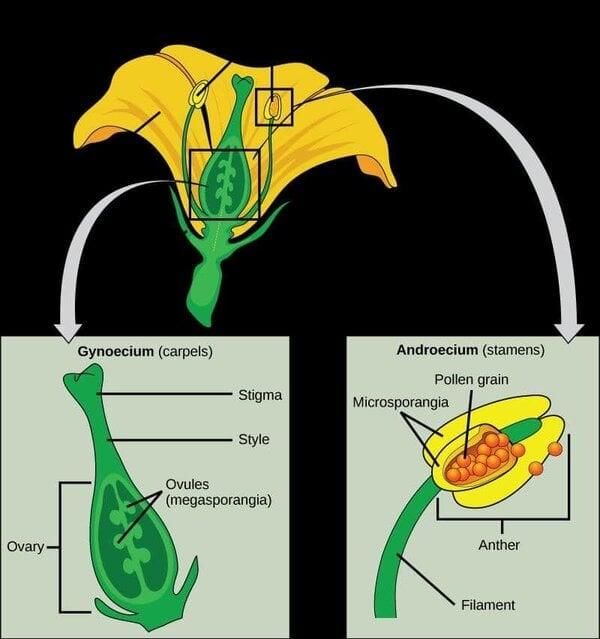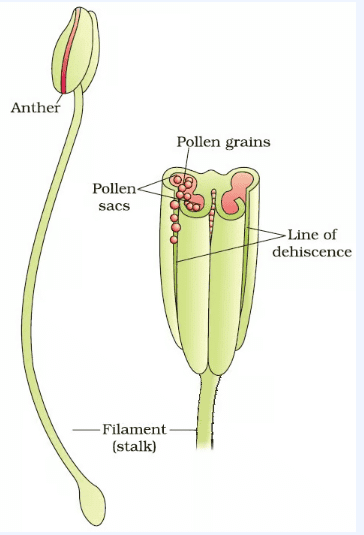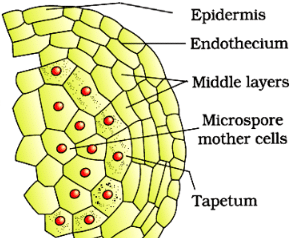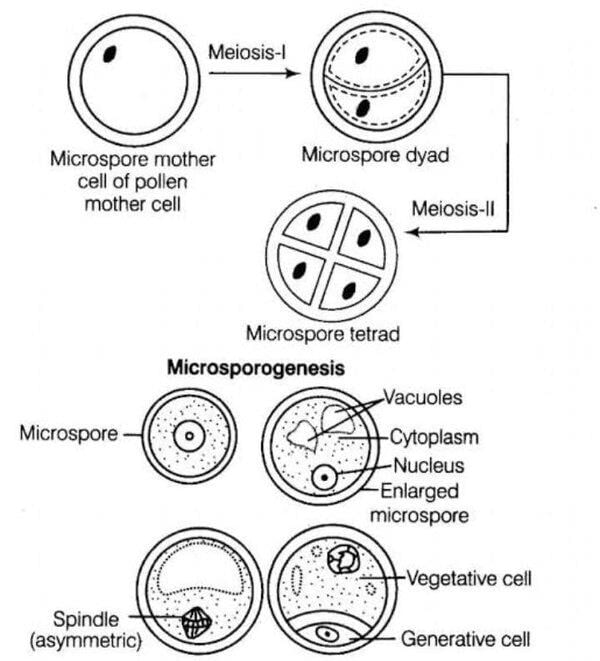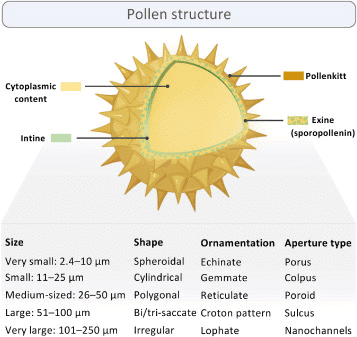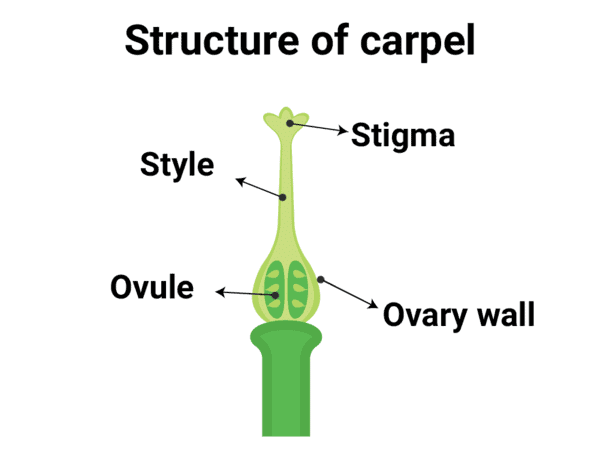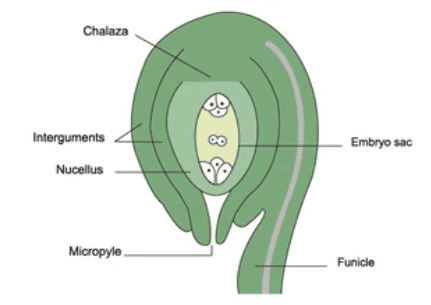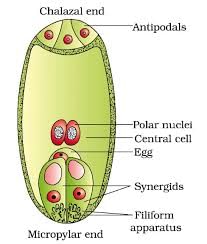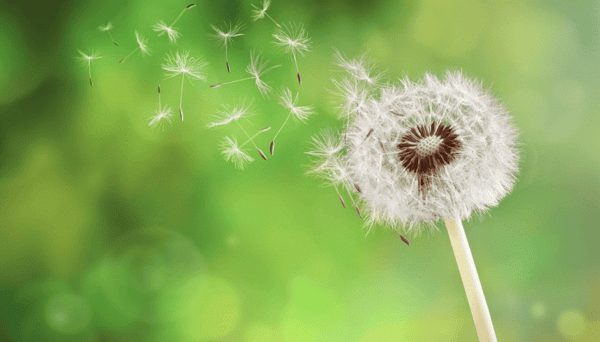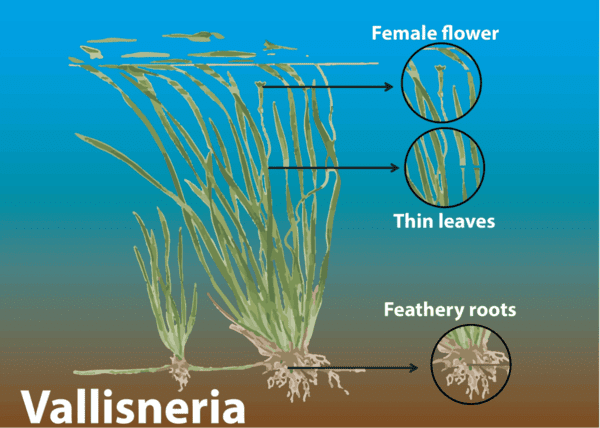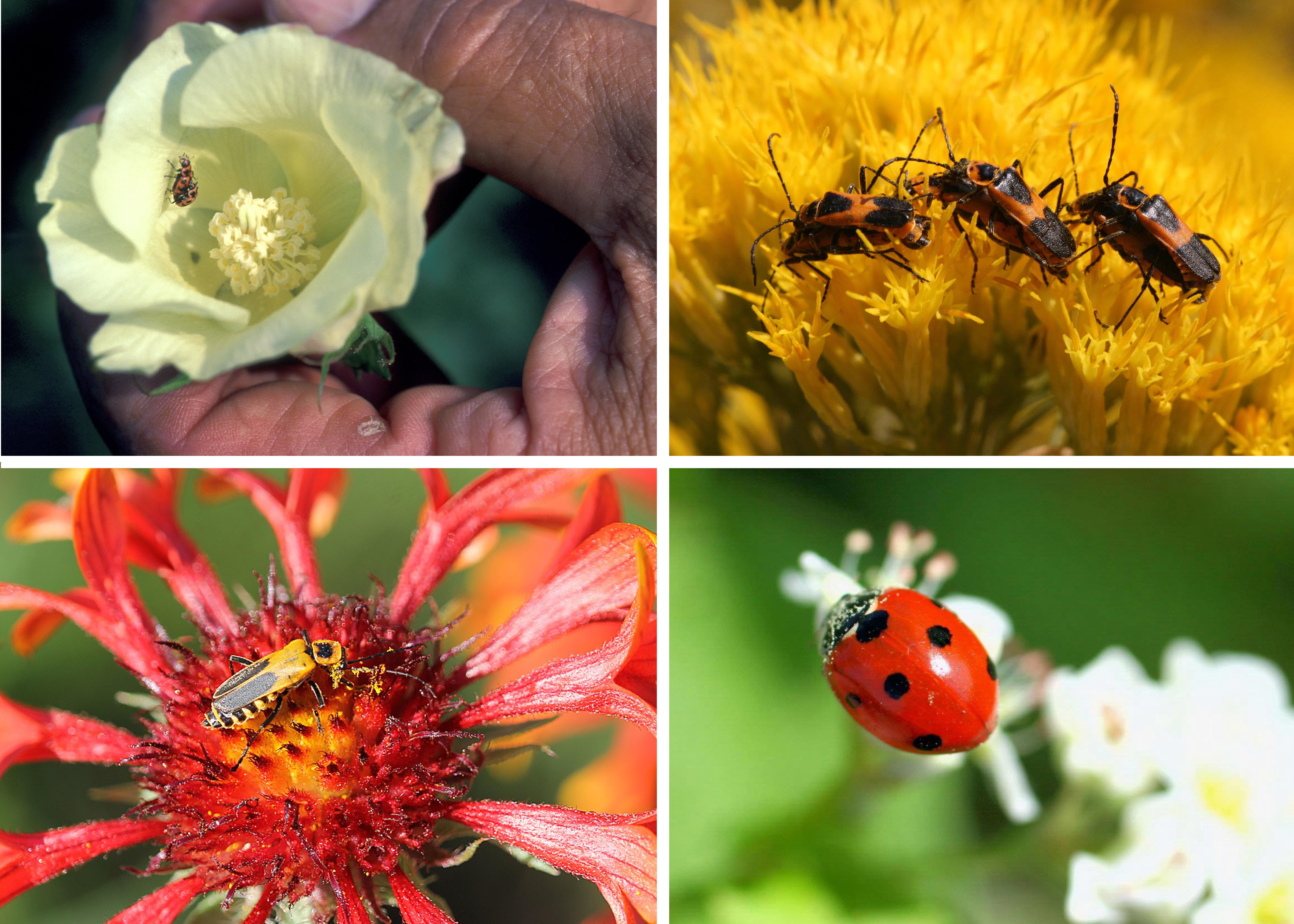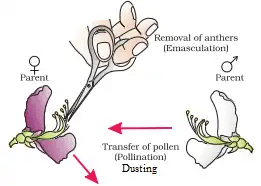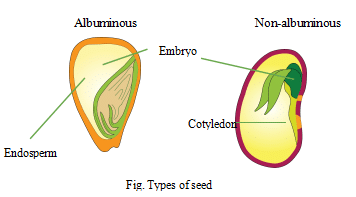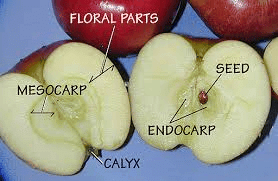|
The two main reproductive whorls of a flower are the androecium and gynoecium, where the smallest unit of the male whorl is called ___ and the smallest unit of the female whorl is called ___. |
Card: 1 / 94 |
|
Fill in the blanks: The anther is a ___ structure that typically is ___, with each lobe containing two theca. |
Card: 3 / 94 |
|
Describe the structure and function of microsporangia in the context of anther development. |
Card: 5 / 94 |
|
Microsporangia are located at the corners of the anther and develop into pollen sacs that contain pollen grains. They are enclosed by four wall layers: epidermis, endothecium, middle layers, and tapetum, which collectively support the development of pollen.
|
Card: 6 / 94 |
|
What are the functions of the different wall layers of a microsporangium during pollen development? |
Card: 7 / 94 |
|
The epidermis, endothecium, and middle layers protect the microsporangium and assist in its dehiscence to release pollen, while the tapetum nourishes the developing pollen grains.
|
Card: 8 / 94 |
|
Describe the process of microsporogenesis and the significance of microspore tetrads. |
Card: 9 / 94 |
|
Card: 10 / 94 |
|
Pollen grains are characterized by their outer layer called the exine, which is made of ___ and serves the purpose of ___. |
Card: 11 / 94 |
|
sporopollenin; providing structural integrity and protection to the pollen grains.
|
Card: 12 / 94 |
|
What are the main structural components of a pollen grain, and what role does each component play? |
Card: 13 / 94 |
|
Card: 14 / 94 |
|
Explain the significance of sporopollenin in the preservation of pollen grains as fossils. |
Card: 15 / 94 |
|
Card: 16 / 94 |
|
Pollen grains are shed in a ___ stage in over 60% of angiosperms, while in others, they are shed in a ___ stage after the generative cell divides. |
Card: 17 / 94 |
|
What role does the stigma play in the fertilization process of flowering plants? |
Card: 23 / 94 |
|
The stigma catches pollen grains, initiating the fertilization process by allowing pollen to travel down the style to the ovary. |
Card: 24 / 94 |
|
What distinguishes a multicarpellary gynoecium from a monocarpellary gynoecium? |
Card: 25 / 94 |
|
A multicarpellary gynoecium consists of more than one pistil, while a monocarpellary gynoecium consists of a single pistil.
|
Card: 26 / 94 |
|
In the structure of an ovule, the area opposite the micropyle is known as the ___. |
Card: 27 / 94 |
|
Integuments encircle the nucellus, providing protection, and they form an opening called the micropyle at the tip, allowing for the entry of pollen. |
Card: 30 / 94 |
|
What is the process called where the embryo sac forms from a single megaspore? |
Card: 31 / 94 |
|
Describe the ploidy levels of the megaspore mother cell and the functional megaspore during megaspore development. |
Card: 33 / 94 |
|
The megaspore mother cell (MMC) is diploid (2n), while the functional megaspore is haploid (n). |
Card: 34 / 94 |
|
Pollination is essential for sexual reproduction in flowering plants, facilitating the transfer of mature pollen grains from the anther to the stigma, which leads to fertilization and the production of seeds.
|
Card: 38 / 94 |
|
Autogamy is a type of pollination that occurs within the same flower, where pollen grains are transferred from the anther to the stigma of that flower. The advantage is assured seed-set without reliance on pollinators, while the disadvantage is limited genetic diversity due to lack of cross-pollination.
|
Card: 40 / 94 |
|
What is the significance of transferring pollen grains from the anther to the stigma of a different plant? |
Card: 43 / 94 |
|
Wind-pollinated plants have light, non-sticky pollen grains, well-exposed stamens, and large, feathery stigmas. They often have a single ovule per ovary and many flowers clustered in inflorescences, such as corn and grasses.
|
Card: 46 / 94 |
|
Water pollination is rare and limited to about ___ genera, mostly ___; describe the pollination process in Vallisneria. |
Card: 47 / 94 |
 Unlock all Flashcards with EduRev Infinity Plan Starting from @ ₹99 only
|
|
30 genera, mostly monocotyledons; in Vallisneria, female flowers rise to the water surface while male pollen is released into the water and carried to the female flowers.
|
Card: 48 / 94 |
|
What adaptations do insect-pollinated flowers typically have to attract pollinators? |
Card: 49 / 94 |
|
Insect-pollinated flowers are usually large, colorful, fragrant, and rich in nectar, often clustered in inflorescences to enhance visibility.
|
Card: 50 / 94 |
|
Explain the role of nectar and pollen in the pollination process and how some insects can act as robbers. |
Card: 51 / 94 |
|
Nectar and pollen serve as rewards for animals, attracting them to flowers. As animals collect these resources, they transfer pollen between flowers, facilitating pollination. However, some insects may consume nectar or pollen without pollinating, known as nectar or pollen robbers. |
Card: 52 / 94 |
|
What are the primary differences in characteristics between abiotic and biotic pollinated flowers? |
Card: 53 / 94 |
|
Abiotic pollinated flowers, such as those pollinated by wind or water, are typically not colorful and do not produce nectar, as they do not need to attract animals. In contrast, biotic pollinated flowers are colorful, fragrant, and produce nectar to attract animals for pollination. |
Card: 54 / 94 |
|
Self-incompatibility is a genetic mechanism that prevents self-pollen from fertilizing ovules, thus inhibiting pollen germination or pollen tube growth in the pistil. This mechanism promotes cross-pollination and reduces the risk of inbreeding depression, enhancing genetic diversity. |
Card: 56 / 94 |
|
The process from pollen deposition on the stigma to the entry of pollen tubes into the ovule is known as ___ and involves ___ between the pollen and pistil. |
Card: 57 / 94 |
|
What are the key steps involved in the process of emasculation and bagging in flowering plants? |
Card: 59 / 94 |
|
Emasculation involves removing anthers from bisexual flowers before they dehisce to prevent self-pollination. The emasculated flower is then covered with a suitable bag to protect the stigma from unwanted pollen. Once the stigma is receptive, desired pollen is dusted onto it, and the flower is rebagged to allow fruit development.
|
Card: 60 / 94 |
|
During fertilization, one male gamete fertilizes the ovule, forming a zygote that develops into an embryo. The other male gamete fuses with the polar nuclei to form the endosperm nucleus, which provides nourishment to the developing embryo. |
Card: 62 / 94 |
|
In the context of unisexual flowers, what is the procedure for ensuring successful pollination? |
Card: 63 / 94 |
|
In unisexual flowers, emasculation is not necessary. The female flower buds are bagged before they open to prevent contamination. When the stigma becomes receptive, pollination is carried out using the desired pollen, ensuring that only the intended pollen fertilizes the ovule. |
Card: 64 / 94 |
|
What are the two types of fusion that occur during double fertilisation in flowering plants? |
Card: 65 / 94 |
|
The male gamete fuses with the egg cell to form a diploid zygote, and the other male gamete fuses with the two polar nuclei to produce a triploid primary endosperm nucleus.
|
Card: 66 / 94 |
|
Double fertilisation is a unique event to flowering plants that ensures the proper development of the ___, which provides nutrients to the developing embryo. |
Card: 67 / 94 |
|
Describe the roles of the primary endosperm cell (PEC) and the zygote after double fertilisation. |
Card: 69 / 94 |
|
The primary endosperm cell (PEC) develops into the endosperm, which nourishes the embryo, while the zygote develops into the embryo itself. |
Card: 70 / 94 |
|
What are the two main stages of endosperm development following fertilization? |
Card: 71 / 94 |
|
The two main stages of endosperm development are the free-nuclear stage, where the primary endosperm nucleus divides to form free nuclei, and the cellular stage, where cell walls form around these nuclei. |
Card: 72 / 94 |
|
How does the fate of the endosperm differ between seeds such as pea and castor? |
Card: 73 / 94 |
|
In seeds like pea, the endosperm is completely consumed by the developing embryo before seed maturation, whereas in seeds like castor, the endosperm persists in the mature seed and is utilized during seed germination. |
Card: 74 / 94 |
|
Describe the structure of a dicotyledonous embryo, including its key components. |
Card: 75 / 94 |
|
A dicotyledonous embryo consists of an embryonal axis, which includes the epicotyl (above the cotyledons) ending with the plumule, and the hypocotyl (below the cotyledons) ending with the radicle covered by a root cap. It has two cotyledons.
|
Card: 76 / 94 |
|
The early stages of embryo development are similar in both monocotyledons and ___ plants. |
Card: 77 / 94 |
|
In a dicotyledonous embryo, the embryonal axis consists of the epicotyl and the ___ which ends with the radicle. |
Card: 79 / 94 |
|
The typical seed consists of a protective outer coat, one or more cotyledons, and an ___ axis. |
Card: 81 / 94 |
|
Albuminous seeds retain a part of the endosperm, while non-albuminous seeds do not have any leftover endosperm, relying solely on cotyledons for stored food.
|
Card: 84 / 94 |
|
The micropyle is a small pore in the seed coat that allows oxygen and water to enter the seed during germination, which is essential for the seed to begin the growth process.
|
Card: 86 / 94 |
|
False fruits, like apples and strawberries, develop from both the ovary and the thalamus, while true fruits develop solely from the ovary.
|
Card: 88 / 94 |
|
Apomixis is a type of reproduction that results in offspring that are ___ to the parent plant. |
Card: 89 / 94 |
|
In polyembryony, multiple embryos develop within a single ovule due to the division of ___ cells surrounding the embryo sac. |
Card: 91 / 94 |
|
The main advantage of converting hybrid varieties into apomicts is that it allows farmers to reuse seeds without ___ of traits in subsequent generations. |
Card: 93 / 94 |





